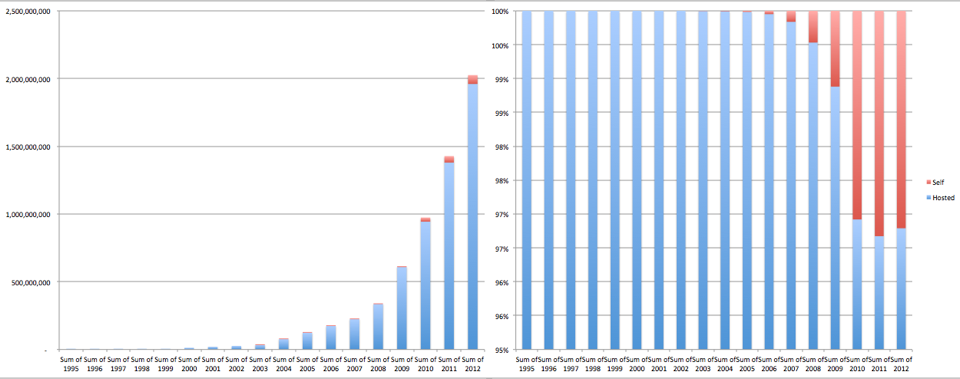I’ve been thinking about the Posterous shutdown, and about previous large-hosted-service shutdowns, going all the way back go Geocities. I think I’ve been so deep in the host-your-own-stuff world that I haven’t been seeing the larger context. Just because I host my stuff, and just because most of the people I know host some (or most) of their stuff, doesn’t mean that the rest of the online population does the same thing. But, how far out of whack are my feelings about the commonality of people managing their own stuff?
I spent a few hours today trying to dig up historical numbers for people using various tools and services to host content. It was surprisingly difficult to find historical data for the number of people with active accounts or downloads of various tools and services. So, I had to settle for cobbling together numbers from various press releases and questionable online reports.
Here’s a rough timeline of active content producers, from 1995 – when Geocities kicked off – to the end of 2012. The figure on the left is raw numbers of people publishing online, using hosted services (blue) or self-hosted software (red). The figure on the right is the proportion of the active content producers using hosted services (blue) or self-hosted software (red) – note that this figure is zoomed in at the 95-100% range because, not surprisingly, almost everyone uses hosted services.

Services that I could find numbers for:
- Blogger
- Geocities (now defunct)
- Livejournal
- MySpace
- Posterous (now defunct)
- Tumblr
- WordPress (.org and .com)
I haven’t been able to find numbers for Movabletype or Typepad, or a long list of other tools and services. I’ll keep poking around, and will update the figures when I find more data… This also doesn’t include the ~50 million Flickr users etc… (yet).1
It boils down to this – almost everyone – well over 95% of people – use hosted services to publish their content (if they publish content at all). And, these hosted services have a long history of withering or closing down entirely. With about 2 billion accounts2, and with almost all of that publishing activity occurring in hosted services, we will need to come to terms with what that means for an online culture when these now incredibly popular services do what hosted services do.
Do we step up attempts to archive these services, as the Internet Archive did with the 650GB of data from Geocities? Do we attempt to help distribute content across multiple services or self-hosted websites to try to mitigate the impact of any one of these services disappearing?
Do we even care? Does this stuff even really matter, or am I just over thinking this?
I wonder what is the average length of time a self-hosted space stays up versus hosted? We obviously have this perception that hosted services are ticking time bombs, but realistically I’m not so sure self-hosted spaces are any more permanent (if that’s even a concern here). I see students in ds106 choose to stop paying for a domain/hosting all the time and their stuff just disappears. Self-hosted is still hosted, the difference being it’s only backed by you and your wallet rather than a larger entity with the business goal of keeping it online. That has obvious tradeoffs in terms of control and ownership. But if we wonder what a web would look like where more and more people were hosting their own stuff, I just worry that the biggest tradeoff there is that more and more stuff disappears at a much faster rate.
I’d be willing to say that self-hosted blogs may have a shorter halflife than hosted-server-blogs. but if a self-hosted blog goes down, the damage is confined to the one blog (or perhaps a handful who share a server). If a hosted-server goes down, it’s going to be several orders of magnitude worse. It’s as much about mitigating risk and damage as it is about anything else. epidemiology of online ecosystems, preventing pandemics, as it were…
Important issue and interesting timeline. Thank you! I posted it on my blog. No doubt that, roughly, it reflects reality. However I wonder how the red figures (the numbers of the self-hosted content) can be obtained. ¿Did you look at WordPress.org downloads? ¿Or at a report?
Like you say, the numbers are extremely sketchy, based on secondary sources. I tried to get numbers for WordPress.org downloads, but even that wasn’t straightforward because Automattic combines both .com and .org users in their rolling counter. Based on snapshots mentioned in conference presentations (Matt’s State of WordPress talks, etc…)